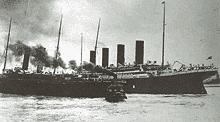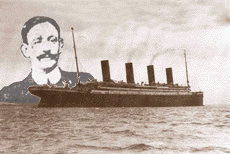
As the sailing date drew near, workmen were still putting the finishing touches on the Titanic, painting, carpeting and furnishing her luxurious cabins and public rooms. Finally, at 9:30 a.m. on April 10, the boat train from Londonís Waterloo Station arrived, and second-class and third-class passengers began to come aboard. Two hours later, the special boat train from London pulled up, carrying many of the shipís first-class passengers. Before the shipís departure, passengers and guests explored the vast Titanic, inspecting her electric elevators, kitchens, libraries and the gymnasiumís mechanical camels and horses.
Then, at noon, the Titanicís huge, triple-toned whistles blew, the visitors debarked, and the ship steamed into the River Test.
 As
passengers waved goodbye from her decks and windows the Titanic
narrowly missed colliding with the berthed liner New York, which
had broken her moorings and drifted perilously toward the Titanic.
After that close call, however, passengers enjoyed a relaxing Channel
crossing. That evening, the Titanic stopped in Cherbourg, France,
the second point of embarkation, to take on about two hundred and fifty
more passengers. Just
after 8:00 p.m., the Titanic began her first night at sea, and
continued toward Queenstown, where she arrived the next morning to pick up
more mail and about half as many passengers as in Cherbourg.
As
passengers waved goodbye from her decks and windows the Titanic
narrowly missed colliding with the berthed liner New York, which
had broken her moorings and drifted perilously toward the Titanic.
After that close call, however, passengers enjoyed a relaxing Channel
crossing. That evening, the Titanic stopped in Cherbourg, France,
the second point of embarkation, to take on about two hundred and fifty
more passengers. Just
after 8:00 p.m., the Titanic began her first night at sea, and
continued toward Queenstown, where she arrived the next morning to pick up
more mail and about half as many passengers as in Cherbourg. On the 11th of April, 1912, the Titanic was finally ready to set sail for New York. At about 1:30 in the afternoon, with just over 2,200 passengers and crew, she began her departure from Queenstown Harbor.
 As
the Titanic eased out of the harbor, the bagpipes of third class
passenger Eugene Daly could be heard at the stern offering the somber tune
of "Erin's Lament" as the Maiden Voyage began.
As
the Titanic eased out of the harbor, the bagpipes of third class
passenger Eugene Daly could be heard at the stern offering the somber tune
of "Erin's Lament" as the Maiden Voyage began. During the first few days of the ocean voyage, passengers enjoyed an exceptionally calm crossing and a pampered routine. The crew, however, was coping with a number of difficulties, including a smoldering fire in one of the shipís coal bunkers and a breakdown in the Titanicís wireless system. Meanwhile, as Captain Smith was steadily increasing the Titanicís speed, ice warnings were coming in from La Touraine, the Rappahannock and other ships in the North Atlantic lanes.